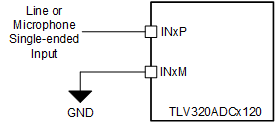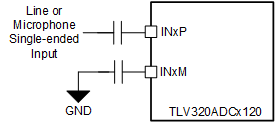SBASB12 May 2024 PCM1809
PRODUCTION DATA
- 1
- 1 Features
- 2 Applications
- 3 Description
- 4 Pin Configuration and Functions
- 5 Specifications
-
6 Detailed Description
- 6.1 Overview
- 6.2 Functional Block Diagram
- 6.3
Feature Description
- 6.3.1 Hardware Control
- 6.3.2 Audio Serial Interfaces
- 6.3.3 Phase-Locked Loop (PLL) and Clock Generation
- 6.3.4 Input Channel Configurations
- 6.3.5 Reference Voltage
- 6.3.6
Signal-Chain Processing
- 6.3.6.1 Digital High-Pass Filter
- 6.3.6.2
Configurable Digital Decimation Filters
- 6.3.6.2.1
Linear Phase Filters
- 6.3.6.2.1.1 Sampling Rate: 8 kHz or 7.35 kHz
- 6.3.6.2.1.2 Sampling Rate: 16 kHz or 14.7 kHz
- 6.3.6.2.1.3 Sampling Rate: 24 kHz or 22.05 kHz
- 6.3.6.2.1.4 Sampling Rate: 32 kHz or 29.4 kHz
- 6.3.6.2.1.5 Sampling Rate: 48 kHz or 44.1 kHz
- 6.3.6.2.1.6 Sampling Rate: 96 kHz or 88.2 kHz
- 6.3.6.2.1.7 Sampling Rate: 192 kHz or 176.4 kHz
- 6.3.6.2.2 Low-Latency Filters
- 6.3.6.2.1
Linear Phase Filters
- 6.4 Device Functional Modes
- 7 Application and Implementation
- 8 Power Supply Recommendations
- 9 Layout
- 10Device and Documentation Support
- 11Revision History
- 12Mechanical, Packaging, and Orderable Information
Package Options
Mechanical Data (Package|Pins)
- RTE|20
Thermal pad, mechanical data (Package|Pins)
Orderable Information
6.3.4 Input Channel Configurations
The device consists of two pairs of analog input pins (INxP and INxM). These pins can be configured as differential or single-ended inputs for the recording channel. The device supports simultaneous recording of up to two channels using the high-performance stereo ADC. The input source for the analog pins can be from electret condenser analog microphones, micro electrical-mechanical system (MEMS) analog microphones, or line-in (auxiliary) inputs from the system board.
The voice or audio signal inputs can be capacitively coupled (AC-coupled) or DC-coupled to the device.For best distortion performance in AC-coupled mode, use the low-voltage coefficient capacitors. The typical input impedance for the PCM1809 is 10 kΩ for the INxP or INxM pins. The value of the coupling capacitor in AC-coupled mode must be chosen so that the high-pass filter formed by the coupling capacitor and the input impedance do not affect the signal content. Before proper recording can begin, this coupling capacitor must be charged up to the common-mode voltage at power-up. To enable quick charging, the device has a quick charge scheme to speed up the charging of the coupling capacitor at power-up. The value of the quick-charge timing is set for a coupling capacitor up to 1 µF.
The INxM pin can be directly grounded in single-ended mode (see Figure 6-7 for DC-coupled) and (see Figure 6-8 for AC-coupled) for the single-ended input configuration. For the best dynamic range performance, the differential AC-coupled input must be used.
 Figure 6-7 Single-Ended, DC-Coupled Input Connection
Figure 6-7 Single-Ended, DC-Coupled Input Connection Figure 6-8 Single-Ended, AC-Coupled Input Connection
Figure 6-8 Single-Ended, AC-Coupled Input Connection